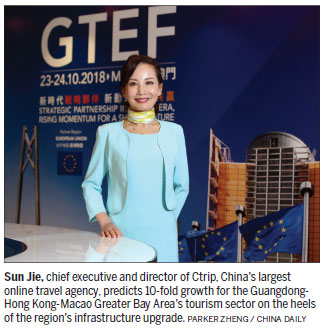Ctrip expects 20% business boost as Bay Area revs up
Updated: 2018-11-02 06:10
By Chai Hua in Macao(HK Edition)
|
|||||||
Ctrip - China's largest online travel agency - is eyeing an annual 20-percent surge in its tourism business in the Guangdong-Hong Kong-Macao Greater Bay Area as mega transportation projects come on stream.
Sun Jie, chief executive and director of the Shanghai-based company, told China Daily before attending the Global Tourism Economy Forum in Macao she's very positive about the region's market potential.
"The region's GDP and travel economy are expected to rise by 5 and 10 percent, respectively, each year, while Ctrip is aiming for an annual growth rate four times that of GDP," she said.
To prepare for that, she said the agency had launched the "high-speed rail trip" travel program, which links various destinations in the Bay Area at "very reasonable" costs.
The package hit the Chinese mainland market in early September - just before the opening of the Hong Kong section of the Guangzhou-Shenzhen-Hong Kong Express Rail Link. It saw Ctrip winning hundreds of thousands of bookings from travelers.
The company's strategy, Sun said, is to provide one-stop services linking transportation with hotel and taxi bookings, ticket purchasing and various tour activities.
According to the Hong Kong Immigration Department, up to 210,000 commuters entered the SAR on high-speed trains between Oct 1 and 6 - the National Day "Golden Week" - accounting for 15 percent of the total number of mainland visitors.
Sun said the mobility of the population within the Bay Area is becoming more frequent, and more people outside the circle are flowing in.
Another major infrastructure project - the Hong Kong-Zhuhai-Macao Bridge - opened to cross-boundary traffic on Oct 24, shortening the drive time between Hong Kong and Zhuhai in Guangdong province from about four hours to 45 minutes.
Travel agencies are relying on the mega bridge for launching new group travel products. The world's longest tunnel-cum-sea crossing is also a new attraction for individual travelers who prefer making road trips.
HZMB Authority, which manages the bridge's operations, estimates that up to 20,000 cars and 50,000 people will use the crossing daily in its first year of operation.
With these vital infrastructure facilities in place, Sun believes that weekend outings and holidays would have the most potential in the region, while business and family travel will also increase.
She urged the relevant authorities to introduce more open policies to further encourage cross-boundary travel with social and business mobility set to climb.
Meanwhile, the number of international tourists from Southeast Asia and European countries is also on the rise, so more friendly visa policies, such as allowing travelers to apply for visas online or through mobile networks, will make their travel more convenient, Sun said.
However, she warned that the growing demand for travel in the Bay Area may present a challenge to local tourist accommodation capacity, and tourists may encounter unpleasant experiences in the short term, such as having to endure long queues.
Several mainland and Hong Kong travel agencies had reported selling out their first group trips via the HZMB in just four days.
Therefore, it's important for industry players to make long-term preparations for a 10-fold growth in business, said Sun.
grace@chinadailyhk.com

(HK Edition 11/02/2018 page9)